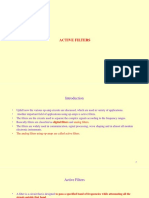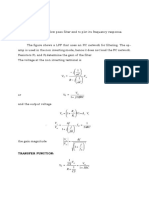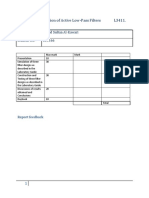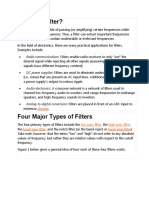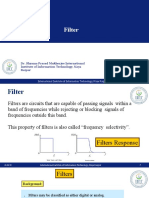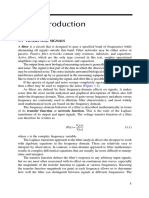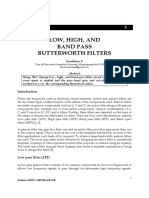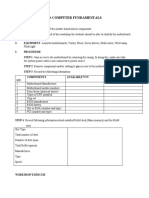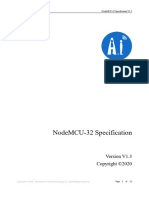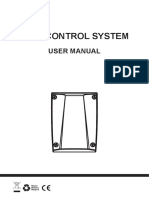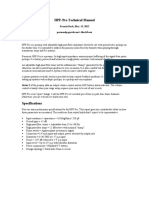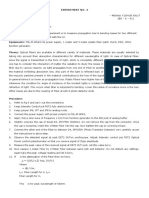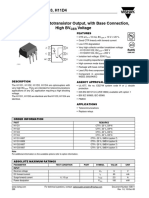Practical - 01
EMC 2082 MEASUREMENT AND INSTRUMENTATION
STUDYING AND DESIGNING ACTIVE AND PASSIVE FILTERS
NAME: JAYASIRI U.G.L.
INDEX NO:EGT/23/473
GROUP NO: EET(C01)
DATA:2025/07/17
�OBJECTIVES
▪ To design Passive and Active filter circuits
▪ To measure the voltage gain of the filter circuit and plot the frequency response curve
▪ To determine the values of lower and 3-dB frequencies and 3-dB bandwidth of the filter
Circuit.
INTRODUCTION
Passive filter
A passive filter is an electronic circuit that uses only passive components such as resistors, capacitors, and
inductors to filter specific frequency ranges in a signal. Unlike active filters, passive filters do not require an
external power source and cannot amplify signals. they can only pass or attenuate frequencies. These filters work
by using the natural frequency-dependent behavior of capacitors and inductors. Capacitors block low frequencies
and pass high frequencies, while inductors do the opposite.
➢ Low-Pass Filter (LPF): Allows signals with frequencies below a certain cutoff frequency to pass and
attenuates higher frequencies.
➢ High-Pass Filter (HPF): Allows signals with frequencies above a certain cutoff frequency to pass and
attenuates lower frequencies.
➢ Band-Pass Filter (BPF): Allows signals within a specific frequency range to pass and attenuates
frequencies outside this range.
➢ Band-Stop Filter (BSF) or Notch Filter: Attenuates signals within a specific frequency range and allows
frequencies outside this range to pass.
Passive filters offer advantages such as simplicity, cost-effectiveness, and no power requirement, making them
reliable and easy to use. They are ideal for high-frequency applications and are commonly used in audio systems,
power supplies, communication systems, and EMI suppression. However, passive filters cannot amplify signals,
and their performance is limited by the components used. Inductors can be bulky, especially for low-frequency
designs, and filter characteristics cannot be changed dynamically. Despite these limitations, passive filters are
widely used in both basic and advanced electronic systems.
Active filter
An active filter is an electronic circuit that uses active components like operational amplifiers (op-amps),
transistors, or FETs along with passive components such as resistors and capacitors. Unlike passive filters, active
filters can amplify signals and require an external power source. They are used to filter specific frequency ranges
and are capable of providing gain, which makes them very effective for signal processing applications. Op-amps
used in active filters provide high input impedance and low output impedance, which helps avoid signal loss due
to loading effects. Active filters are designed in various forms, including low-pass, high-pass, band-pass, band-
stop (notch), and all-pass filters, each serving different purposes in filtering out or passing certain frequencies
.there are three popular types of filter called Butterworth, Chebyshev, and Bessel low-pass filters:
Butterworth Low-Pass Filter:Flat frequency response in the passband (no ripples).Smooth and gradual roll-off
after the cutoff frequency. When a clean, ripple-free passband is more important than sharp cutoff. .it used Audio
circuits, measurement systems.
Chebyshev Low-Pass Filter: Sharper cutoff than Butterworth, but with ripples in the passband (Type I) or
stopband (Type II).Faster transition from passband to stopband. When sharper filtering is needed and some ripple
is acceptable. There are application such as Communication systems, signal processing.
Bessel Low-Pass Filter:Best phase response and linear group delay. Slower roll-off than Butterworth or
Chebyshev, but keeps waveform shape of signals (minimal distortion).When signal timing and shape are critical.
�Example like that Audio, video, and data transmission where timing is important.
DIAGRAM
Experiment – 01
Figure01
Experiment – 02
Figure02
Experiment – 03
Experiment – 04
Figure04
�Experiment – 05
Figure05
PROCEDURE
Experiment 01:
▪ The oscilloscope channels were set to AC mode.
▪ The low-pass filter (LPF) was built shows figure01 using a 1 kΩ resistor and a 0.0047 μF capacitor.
▪ A 10 V peak-to-peak sine wave at around 9 kHz was applied from the function generator without DC
offset.
▪ The input and output voltages and the time delay were measured.
▪ The same steps were repeated for other frequencies (9, 17, 30, 50, 150 kHz).
▪ The circuit was tested using a 300 kHz square wave.
Experiment 02:
▪ The high-pass filter (HPF) was built shows figure02 using a 47 kΩ resistor and a 0.0047 μF capacitor.
▪ A 10 Vpp sine wave at around 100 Hz was applied.
▪ All voltage and delay readings were recorded.
▪ The test was repeated for other frequencies.
▪ A 50 Hz triangle wave was used to test the circuit in the final step.
Experiment 03:
▪ The transfer function of a low-pass filter was presented shows figure03.
▪ R1 and C1 were chosen so that the cutoff frequency was around 1 kHz.
▪ C = 47 nF was used, and the required resistor was calculated.
▪ The filter was built and the output signal was observed.
▪ The gain at different frequencies was measured.
Experiment 04:
▪ The transfer function of an amplifying low-pass filter was analyzed(figure04).
▪ R = 6.8 kΩ and C = 0.1 μF were selected.
▪ Amplifier gain was set to 2 by choosing correct R1 and R2.
▪ The circuit was built, and gain across frequencies was measured.
▪ Frequency response was plotted and gain and cutoff frequency were determined.
Experiment 05:
▪ A first-order high-pass filter(figure05) with gain was designed using a non-inverting amplifier.
� ▪ Cutoff was set to 1 kHz using a 0.01 μF capacitor and R3 was calculated.
▪ The circuit was built and gain was set to 2 using R1 and R2.
▪ Gain was measured at several frequencies.
▪ A frequency response graph was plotted, and the gain and 3dB cutoff frequency were found.
CALCULATION
�DISCUSSION
We explored a variety of filter types, including passive low-pass and high-pass filters, as well as active non-
inverting filters with and without amplification. Each filter was designed for a specific function, and our
experiments highlighted both their practical uses and limitations. We observed that real-world circuit behavior
often differs from theoretical expectations due to small construction errors, variations in component values, and
the physical setup on the breadboard. These observations showed us how important it is to be accurate in both
designing and building circuits. However, due to time constraints in the laboratory, we were unable to complete
Experiments 04 and 05, which involved designing active filters with gain. This limited our ability to fully observe
and analyze the performance of active filters with amplification. Even so, the experiments we completed provided
valuable insight into the behavior of basic filter circuits and reinforced the connection between theory and
practical application.
The passive filters we constructed low-pass and high-pass were simple and cost-effective, relying solely
on resistors and capacitors. The low-pass filter successfully attenuated high-frequency signals while allowing
lower frequencies to pass, though it lacked amplification capability. Similarly, the high-pass filter blocked lower
frequencies and passed higher ones but suffered from reduced output strength, especially when paired with low-
resistance loads. Both filters are commonly used in applications such as noise suppression in audio systems and
signal conditioning in communication circuits, though their performance is sensitive to component tolerances and
layout.
Active filters, built using operational amplifiers, offered additional advantages including signal
amplification and improved buffering. The non-inverting low-pass filter preserved signal strength while filtering
out unwanted high-frequency noise. When configured with gain, it became suitable for applications with weak
input signals. Likewise, the active high-pass filter effectively removed low-frequency noise while amplifying the
desired frequencies, which is particularly valuable in medical equipment and audio electronics. However, active
designs required careful management of gain levels and power supply conditions to avoid signal distortion.
Overall, the laboratory enhanced our understanding of how passive and active filters function in real-world
conditions and highlighted the importance of meticulous design, testing, and adjustment in practical electronic
systems.
CONCLUSION
we got hands-on experience in creating and testing both passive and active filters. We built different types
of filters low-pass and high-pass, with and without amplification and saw how each one worked with different
signals. Passive filters were easy to build and cheap but couldn't make signals stronger. Active filters, on the other
hand, could amplify signals and perform better, but they needed more careful planning to avoid problems like
distortion or power issues.
By working with real circuits, we saw how theory connects to practical work. We also learned that small
things like component quality and circuit layout can change how well the filter works. This showed us why it’s
important to test circuits, use accurate parts, and plan carefully. Overall, this experiment improved our
understanding of filters and gave us useful skills for designing and fixing electronic circuits used in things like
sound systems, communication tools, and medical devices
REFERENCE
▪ https://www.analog.com/en/analog-dialogue/articles/introduction-to-active-filters.html
▪ https://www.electronics-tutorials.ws/filter/filter_2.html
▪ https://www.learnabout-electronics.org/ac_theory/filters81.php




















